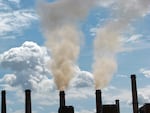
Smokestacks emitting air pollution.
Creative Commons/Flickr/World Bank Photo Collection
At a hearing in Portland Wednesday, Oregon environmental regulators took questions and comments on the
new statewide air pollution rules
they’re proposing.
The rules would limit the total health risk polluters can impose on their neighbors. In the first five years, they would target 80 yet-to-be identified polluters that pose the highest health risks and bring them into compliance.
Their ultimate goal is reducing the cancer risk from industrial air pollution.
Portlanders at the meeting raised concerns that the rules allow too much cancer risk from air pollution, that they give the Oregon Department of Environmental Quality director too much control over how the rules are enforced, and that they don’t do enough to deny permits to businesses that exceed health risk limits.
Several people, including Jessica Applegate with the Eastside Portland Air Coalition, pointed out that that the rules depend on uncertain funding approval from the state Legislature.
“It’s depressing to know that we have a Democratic House, a Democratic Senate and a Democratic governor and we still couldn’t get the funding – the $1 million – to see this program through,” she said. “What the hell is wrong?”
Keith Johnson of the Oregon Department of Environmental Quality said without approval from the Legislature to charge fees to polluters, the state won’t have the funding it needs to hire people to implement the rules. That will leave the state with “minimal and uncertain” new air pollution regulations, he said.
Jennifer Davis told officials that the vegetables in her garden were contaminated by heavy metal air pollution that was only detected last year through moss testing by the U.S. Forest Service.
“I know that the EPA and the DEQ are very poorly funded and the moss was the only way you found out about the arsenic and cadmium in our neighborhood,” she said. “So, I’m wondering, are you going to continue with moss studies and use other forms of monitors, and what can we as citizens do to help you – like, is there a Kickstarter?”
Adam Brunelle with the organization Green Lents said the rules should consider diesel emissions from vehicles when measuring overall health risks in a neighborhood. He also said the rules should include more neighborhoods in its initial consideration of cumulative health risks from multiple air pollution sources.
“There are places where there are a lot of pollutants from multiple different facilities that aren’t polluting a lot on their own and then one community is ending up – especially low-income communities, communities of color are facing a lot more risk,” he said.
Several employees of the local manufacturer Gunderson Marine spoke up to warn regulators about excessive requirements that could harm their jobs and their business and alarm the public without addressing the worst toxic air pollution problems.
Dave Harvey, director of health and safety for Gunderson, said his company has already installed the best available technology to reduce and control its air pollution and reports its emissions to the EPA.
“These new DEQ rules will require us to reanalyze the risk from those same emissions,” he said. “It’s not clear what the results of our new analysis will be. Gunderson will be forced to spend time and money on analysis that could end up with results that unnecessarily alarm members of the public.
While DEQ hasn’t identified the companies that will initially be targeted by the new rules, Harvey said they “seem to be targeting companies like Gunderson that have a longstanding history of controlling their emissions of air toxics.”
The proposed rules won’t address mobile sources of air pollution like diesel trucks or other known pollution sources such as wood stoves, he said, and it’s unclear whether they will target the kind of facilities that caused heavy metal pollution identified in the Forest Service’s moss studies.
“By targeting Gunderson and similar sources our jobs are put at risk and DEQ misses the chance to focus on what will really make a difference in health and safety,” he said.
Officials said the proposed rules are still open to change. They will be taking comments through Dec. 22. They plan to review and respond to all comments before finalizing the rules.
